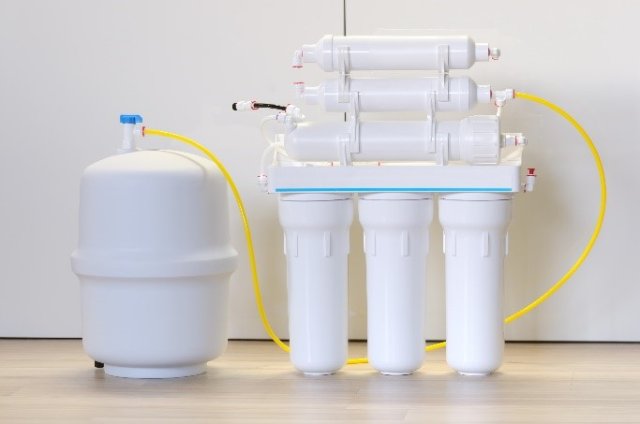Point-of-Use Reverse Osmosis Systems


A point-of-use reverse osmosis (RO) system is a water filtration device that is connected to a single fixture (e.g., under the kitchen sink) and uses the process of RO to remove contaminants from the water supplied to that fixture. RO is the process by which pressure forces water through a semi-permeable membrane, creating a stream of treated water, called “permeate,” and a stream of reject water called “concentrate” or “brine.” These systems can potentially remove water contaminants such as lead, volatile organic compounds (VOCs), PFAS, arsenic, bacteria, and viruses. Point-of-use RO systems are typically installed in residential settings but can also be found in commercial office spaces or kitchens.
On this Page

While RO systems can improve water quality, these systems can also generate a significant amount of water waste to operate. For example, a typical point-of-use RO system will generate five gallons or more of reject water for every gallon of treated water produced. Some inefficient units will generate up to 10 gallons of reject water for every gallon of treated water produced. In contrast, point-of-use RO systems that earn the WaterSense label must demonstrate that they send just 2.3 gallons of water or less down the drain for every gallon of treated water they produce.
All products bearing the WaterSense label are independently certified to ensure they meet EPA criteria for efficiency and performance. The WaterSense specification for point-of-use RO systems ensures that labeled RO systems are just as effective at providing the high-quality treated water consumers expect from these products. For more information on RO systems, including how they work and how to select an RO system that is right for you, view this WaterSense report, Treating Water With Less Waste (pdf) .
While the water provided by public water suppliers in the United States is some of the safest in the world, there are times when consumers may want to employ additional treatment technology to ensure safety of well water or publicly-supplied water. Due to the water-intensive nature of RO, WaterSense does not intend to promote the installation of RO systems for all applications or encourage their use over other water treatment technologies that do not waste as much water (e.g., filtration systems). In some cases, other treatment methods that use little or no water, such as filtration, are sufficient to meet consumer treatment needs. For more information, read the WaterSense Guide to Selecting Water Treatment Systems (pdf).
For consumers who are planning to replace their reverse osmosis system at the point of water use, selecting a WaterSense labeled model will reduce water use on average by more than 3,100 gallons of water per year compared to the water usage of a typical point-of-use RO system. This translates to a savings of 47,000 gallons over the lifetime of the system.
If all point-of-use RO systems sold in the United States were WaterSense labeled, we could save more than 3.1 billion gallons of water across the country annually, which is equivalent to the annual household water needs of nearly 41,000 American homes.
Read the Point-of-Use Reverse Osmosis Systems fact sheet (pdf) for more information.
As part of the WaterSense specification development process, EPA examined key performance metrics to ensure consumer satisfaction. EPA also considered the impact of reducing water waste on RO system performance.
All WaterSense labeled point-of-use RO systems are independently certified to meet performance criteria to ensure user satisfaction and health and safety. Performance criteria address the following areas:
- Membrane Life: Ensures the RO membrane will last at least one year before requiring replacement.
- Total Dissolved Solids Reduction: Ensures a system meets a baseline contaminant reduction level for total dissolved solids.
- Contaminant Reduction: Ensures a system is tested and certified to remove any additional contaminants the manufacturer claims it can remove.
See the Performance Overview for more information on how WaterSense assessed performance when developing the specification.
- WaterSense Performance Overview: Ensuring Products Perform (pdf) (178.51 KB, April 2022)
- WaterSense Performance Overview: Point-of-Use Reverse Osmosis Systems (pdf)
In November 2024, EPA released the WaterSense Specification for Point-of-Use Reverse Osmosis Systems.
- WaterSense Specification for Point-of-Use Reverse Osmosis Systems (pdf)
- WaterSense Specification for Point-of-Use Reverse Osmosis Systems Supporting Statement (pdf)
EPA hosted a meeting for manufacturers to discuss the final specification and process for earning the WaterSense label for RO systems on December 17, 2024. The presentation and recording are available below.
For more information about the specification development process for point-of-use RO systems, including the draft specification, public response to the draft specification, and EPA’s response to public comments, please visit the Specification for Point-of-Use Reverse Osmosis Systems Background Materials Page.
Manufacturers that produce point-of-use RO systems meeting EPA’s efficiency and performance criteria can apply to have their products certified to earn the WaterSense label. Before submitting products for testing, manufacturers must have a partnership agreement with EPA in place. Visit the manufacturer section on the WaterSense partner page to learn more.
